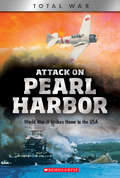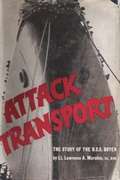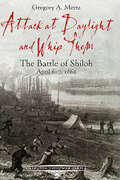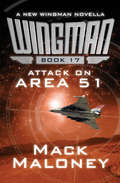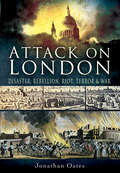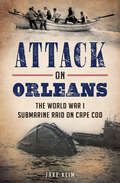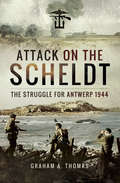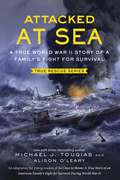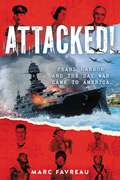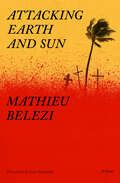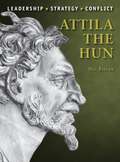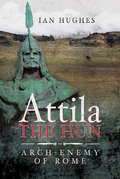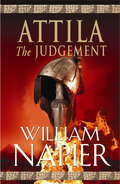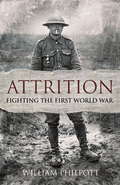- Table View
- List View
Attack On Pearl Harbor: World War Ii Strikes Home In The Usa (Xbooks)
by Steve DoughertyThe U.S. fleet is under attack!High-interest topics, real stories, engaging design and astonishing photos are the building blocks of the XBooks, a new series of books designed to engage and motivate reluctant and enthusiastic readers alike. With topics based in science, history, and social studies, these action-packed books will help students unlock the power and pleasure of reading... and always ask for more!Mess Attendant Dorie Miller wasn't trained for combat. But as Japanese fighter planes fire at his ship, how will Miller and others in the U.S. Navy manage to defend themselves? The Japanese attack on Pearl Harbor on December 7, 1941 brought America into World War II.
Attack On The American Embassy During Tet, 1968: Factors That Turned A Tactical Victory Into A Political Defeat
by Major Robert J. O'BrienWhat could have made the Military Police (MP) and Marine Security Guard (MSG) response more effective, averting negative media coverage and public opinion? The Tet Offensive has been widely acknowledged as the turning point of the United States (U.S.) effort in Vietnam. The Viet Cong and North Vietnamese forces attacked over 100 cities and towns on 31 January 1968, during the Tet holiday. At the epicenter of this cataclysmic event was the attack on the U.S. Embassy. Although this was a platoon level action, the publicity generated would be wildly disproportionate to the value of the Embassy as a military target. Controversy has continued unabated four decades later. The media role in conveying the outcome of the attack is still a subject of debate. The fact that the U.S. forces that successfully defended the Embassy were greatly outnumbered and not organized or equipped as combat troops was not portrayed in media reports.This thesis first examines the attack on the U.S. Embassy during the Tet Offensive of 1968, and what factors turned a tactical victory into a political defeat. The Marine Security Guards (MSGs) and Military Police (MP) were effective at preventing the enemy from entering and holding the Chancery. The MSGs and MPs at the Embassy achieved a clear tactical victory, yet the action was portrayed as a political defeat. Two sets of factors contributed to this portrayal: the political situation, including shifting public opinion and declining media-military relations; and actions taken by the State Department that directly affected the conduct of the action at the Embassy.
Attack Transport: USS Charles Carroll in World War II (New Perspectives on Maritime History and Nautical Archaeology)
by Kenneth H. GoldmanKenneth Goldman's father, Lt. Robert W. Goldman, USNR, was aboard ship for five of her six battle operations. As a junior officer (he eventually became the ship's navigator), he held a high security clearance and saved a large portion of the documents to which he was privy. These invasion maps, photographs, ship's plans of the day, convoy position orders, enemy force assessments, and more form the backbone of Attack Transport.Yet Goldman graciously keeps his father out of center stage in telling the "life" of a ship that participated in almost all of the major U.S. amphibious assaults in the European Theater. Using weathered diaries and letters from other crew members, along with their memories of service, he captures the humor, boredom, combat fears, and capers on liberty that give this view from the lower deck a charm that operational histories do not have.
Attack Transport; The Story Of The U.S.S. Doyen [Illustrated Edition]
by Lt. Lawrence A. Marsden Admiral Richmond Kelly TurnerIncludes the Second World War In The Pacific Illustration Pack - 152 maps, plans and photos."Among the auxiliary classes of the Navy List are two that carry not only an "auxiliary" but also a "combatant" classification letter. These are the attack transports (APA's) and the attack cargo vessels (AKA's). Without belittling the importance of LST's, LSM's, LCT's, and other small types used in the maritime transportation of men and freight, it is the APA's and the AKA's that carry the bulk of the troops and equipment to the bloody assault beaches of our overseas landings. They are the backbone of the Amphibious Forces. These ships arrive with the initial amphibious attacks and continue their support throughout the fighting. Unarmored and with small fire power, they yet carry a great weapon that is war's one essential combat element: the troops that fight on the ground.In war, transports seldom rest. Between assaults, on long and dreary voyages they carry out to distant bases replacement and service troops and freight, and carry back to home ports our casualties and essential war materials. They are the unsung, battle-scarred work horses of the Navy.Transport life was mainly on a humdrum level that had occasional peaks of furious battle. Morale was always high. The resourceful crews of these ships made up for lack of experience through native ingenuity, shining courage, and an eager offensive spirit.As modestly portrayed in Attack Transport, these truly combatant naval vessels of the Amphibious Forces did their share in winning the war.God bless them and the splendid Americans who worked and fought them!"-Admiral Richmond Kelly Turner.
Attack at Daylight and Whip Them: The Battle of Shiloh, April 6–7, 1862 (Emerging Civil War Series)
by Gregory A. MertzThis Civil War history and guide presents an engaging chronicle of the Battle of Shiloh with information and insights about the Tennessee battlefield. The Union Army of the Tennessee, commanded by Major General Ulysses S. Grant, had gathered on the banks of its namesake river at a spot called Pittsburg Landing, ready to strike deep into the heart of Tennessee Confederates, commanded by General Albert Sidney Johnston. Johnston&’s troops were reeling from setbacks earlier in the year and had decided to reverse their fortunes by taking the fight to the Federals. Johnston planned to attack them at daylight and drive them into the river. As a brutal fight ensued, Grant gathered reinforcements and planned a counteroffensive. On the morning of April 7, he initiated his own bloody daybreak attack. The horrors of this two-day battle exceeded anything America had ever known in its history. Historian Greg Mertz grew up on the Shiloh battlefield, hiking its trails and exploring its fields. Attack at Daylight and Whip Them taps into five decades of intimate familiarity with a battle that rewrote America&’s notions of war.
Attack on Area 51 (Wingman #17)
by Mack MaloneyAfter a mysterious disappearance, the ace fighter pilot is back, searching for answers to his missing memory—but still ready to defend post-WWIII America. It&’s been a decade since Hawk Hunter, famed American World War III hero and legendary pilot, vanished on an extraterrestrial mission to save his country. Presumed dead, Hunter found himself in a strange alternate universe where the planes were bigger than seemed possible and the dead walked the earth. Now he is back, and America needs his help once more. The fragile new America that Hunter helped build has shattered in his absence. He has no memory of where he has been for the past ten years, knowing only that he can bring peace to his beloved country once and for all. Seeking answers at the secret research base known as Area 51, Hawk uncovers a strange new threat to his fractured homeland. There is only one thing to do. His memory may be in tatters, but the Wingman has not forgotten how to fly.
Attack on London: Disaster, Riot and War
by Jonathan OatesGenerations of Londoners from Roman times to the present day have confronted natural and man-made threats to their city. Disasters, rebellions, riots, acts of terror and war have marked the long history of the capital—and have shaped the character of its people. In this evocative account Jonathan Oates recalls in vivid detail the perils Londoners have faced and describes how they coped with them. Jack Cade's Rebellion and the Gordon Riots, the Great Plague and the Great Fire, Zeppelin raids, the Blitz, terrorist bombings—these are just a few of the extraordinary hazards that have torn the fabric of the city and wrecked the lives of so many of its inhabitants. This gripping narrative gives a fascinating insight into the tragic history of the city and it reveals much about the changing attitudes of Londoners over the centuries.
Attack on Orleans: The World War I Submarine Raid on Cape Cod (Military Ser.)
by Jake KlimThis true account of a German submarine on the Massachusetts coast was called &“an action-packed page-turner&” by Sen. John McCain. On the morning of July 21, 1918—the final year of the First World War—a new prototype of German submarine surfaced three miles off the coast of Cape Cod, Massachusetts. The vessel attacked an unarmed tugboat and its four barges. A handful of the shells fired by the U-boat's deck guns struck Nauset Beach, giving the modest town of Orleans the distinction of being the only spot in the United States to receive enemy fire during the entire war. On land, lifesavers from the US Coast Guard launched a surfboat under heavy enemy fire to save the sailors trapped aboard the tug and barges. In the air, seaplanes from the Chatham Naval Air Station dive-bombed the enemy raider with payloads of TNT. This book chronicles the attack from the first shell fired to the aftermath, and celebrates the resilience of a small New England town.
Attack on the Scheldt: The Struggle for Antwerp, 1944
by Graham A. ThomasDuring the Allied advance across northwest Europe in 1944, the opening up of the key port of Antwerp was a pivotal event, yet it has been neglected in histories of the conflict. The battles in Normandy and on the German frontier have been studied often and in detail, while the fight for the Scheldt estuary, Walcheren and Antwerp itself has been treated as a sideshow. Graham Thomass timely and graphic account underlines the importance of this aspect of the Allied campaign and offers a fascinating insight into a complex combined-arms operation late in the Second World War. Using operational reports and vivid first-hand eyewitness testimony, he takes the reader alongside 21 Army Group as it cleared the Channel ports of Calais, Boulogne and Dunkirk, then moved on to attack the Scheldt and the island stronghold of Walcheren. Overcoming entrenched German resistance there was essential to the whole operation, and it is the climax of his absorbing narrative.
Attack on the Somme: Haig's Offensive 1916 (Campaign Chronicles)
by Martin PeglerThe Battle of the Somme is fixed in the country's collective memory as a disaster—probably the bloodiest episode in the catalogue of futile offensives launched by the British on the Western Front. Over five months of desperate fighting in 1916 the British wrestled with the Germans for control of a narrow strip of innocuous French countryside. When the fighting petered out the British had barely pushed back the Germans from their original positions for a combined casualty figure of over a million men. But after 80 years this notorious episode in western military history deserves to be reassessed.Previously unpublished eyewitness accounts are used to give a fascinating first-hand view of the immediate experience of the fighting. As Martin Pegler shows, a revision in our assessment of the Somme, in particular of the tactics and the weaponry employed by the combatants, is overdue, and he challenges the traditional assumptions about the course of the battle and its future impact on the development of warfare.
Attacked at Sea: A True World War II Story of a Family's Fight for Survival (True Rescue Series)
by Michael J. Tougias Alison O'LearyA riveting WWII account of survival at sea—Book 4 in the middle grade True Rescue series from Michael J. Tougias, the author of the New York Times bestseller The Finest Hours. <P><P>On May 19, 1942, during WWII, a U-boat in the Gulf of Mexico stalked its prey fifty miles from New Orleans. The submarine set its sights on the freighter Heredia. Most onboard were merchant seamen, but there were also civilians, including the Downs family: Ray and Ina, and their two children. Fast asleep in their berths, the Downs family had no idea that two torpedoes were heading their way. When the ship exploded, chaos ensued—and each family member had to find their own path to survival. This inspiring historical narrative tells the story of the Downs family as they struggle against sharks, hypothermia, blinding oil, drowning, and dehydration in their effort to survive the aftermath of this deadly attack off the American coast.
Attacked!: Pearl Harbor and the Day War Came to America
by Marc FavreauThe true story of Pearl Harbor as you&’ve never read it before—action-packed, informative, and told through the eyes of a diverse group of people who experienced the terror of the unprecedented attack firsthand. A single day changed the course of history: December 7, 1941. Nobody in America knew Japan&’s attack on Pearl Harbor was coming. Nobody was prepared for the aftermath. It became a defining moment from which the country never truly recovered. Perfect for fans of Steve Sheinkin and Deborah Heiligman, this unflinching narrative puts readers on the ground in Pearl Harbor through the stories of real people who experienced the attack and its aftereffects. It alternates between the sweeping views and fateful decisions of leaders such as FDR and on-the-ground accounts from soldiers and sailors of all backgrounds as well as an array of other unique participants and observers. Attacked! sheds new, compelling light onto a history we think we know, what it means to be American, and the enduring lessons from an event we never saw coming.
Attacking Earth and Sun: A Novel
by Mathieu BeleziThis searing historical fiction immerses us in the brutal early days of the 19th-century French colonization of Algeria. The highly anticipated English-language debut of a prize-winning author who tackles the taboo of France&’s colonial past.In search of a prosperous life, Séraphine and her family brave the dangerous journey to France&’s newly conquered Algerian territory, along with five hundred likeminded citizens. But the realities of the colony soon give the lie to the French government&’s promises: inadequate shelter, hostile weather, sickness, and a native population whose anger and desperation threaten to boil over into violence.As the settlers gradually, painfully establish a community and a church in this foreign land, the French army wreaks devastation on the Algerian people and their villages. Through the eyes of a soldier—constantly reminded by his captain, &“You&’re no angels!&”—we witness their shocking cruelty as they attempt to quell resistance.With chiseled, haunting prose reminiscent of Faulkner, Mathieu Belezi condenses years of historical research into a powerfully human account. Attacking Earth and Sun vividly exposes the hell that was colonization, far from the pioneer dream sold by Western powers.
Attila the Hun
by Nic Fields Steve NoonAttila the Hun is one of the iconic figures of history. In a series of epic campaigns dating from the AD 430s till his death in AD 453 he ravaged first the Eatsern Roman Empire and later the Western Roman Empire, invading Italy itself in AD 452 threatening Rome itself.The Huns had moved into Europe in the AD 370s, annexing the territory of the Alans and settling in the Danube region. In AD 433 Rua King of the Huns, died. Rua, an ally of Aetius and the West Romans, was succeeded by his nephews Bleda and Attila. When Attila murdered his brother and ruled alone things began to change. In two campaigns against the Eastern Empire (AD 441-42 and 447) the Huns devastated the Balkans and exacted a heavy tribute. In AD 450 Attila turned his attention to the West. When Attila crossed the Rhine he met very little resistance. Some towns opened their gates to him, others were captured and sacked including Trier, Metz and Reims. Attila's strategy was to keep moving, thereby reducing his logistical problems and, by his devastation of Roman Gaul, force the Western Empire to come to terms with him. He met his major setback at the battle of Chalons in AD 451, also known as the battle of Campus Mauriacus or Catalaunian Plains, when the Roman warlord Flavius Aetius cobble together a hodgepodge force of Visigoths, Franks, Burgundians, Alans, Saxons, Armorican Britons and Romans who together they managed to drive Attila the Hun out of France by defeating his equally mixed army of Huns, Ostrogoths, Gepids, Franks, Rugians, Thuringians, Burgundians.Despite this setback, Attila invaded Italy the following year, sacking and razing the cities of Aquileia, Vicetia, Verona, Brixia, Bergamum and Milan. Having retired to his Carpathian heartland, Attila died in AD 453 and his empire did not long survive him.This new study explores his extraordinary conquests and the abilities that led him to his establish such a far-flung empire.
Attila the Hun: Arch-Enemy of Rome
by Ian HughesA biography of the notorious tribal leader whose empire challenged the Romans. Most know the name Attila the Hun—but few are familiar with the full history behind this historical figure. Rising to the Hunnic kingship around 434, he dominated European history for the next two decades. Attila bullied and manipulated both halves of the Roman Empire, forcing successive emperors to make tribute payments or face invasion. Here, Ian Hughes recounts Attila&’s rise to power, attempting to untangle his character and motivations so far as the imperfect sources allow. A major theme is how the two halves of the empire finally united against Attila, prompting his fateful decision to invade Gaul and his subsequent defeat at the Battle of the Catalaunian Plain in 451. Integral to the narrative is analysis of the history of the rise of the Hunnic Empire; the reasons for the Huns&’ military success; relations between the Huns and the two halves of the Roman Empire; Attila&’s rise to sole power; and Attila&’s doomed attempt to bring both halves of the Roman Empire under his dominion.
Attila: The Judgement
by William NapierThe battlefields run with blood in this gripping finale to the bestselling Attila trilogy.The infamous leader of the Huns stills thirsts for blood and supremacy as he crosses the Danube and prepares to attack the Western Empire and face once more his boyhood friend-turned-foe: Aetius the Roman.For Attila is set on a plan that will take him right through the entire Italian peninsular and up to the gates of Rome. He must weigh up whether he should attack this, the greatest of cities, or whether the gamble is too high, even for the most battle-hardened of warlords. In this tumultuous conclusion to the life of the warrior, we see the biggest choices of his blood-soaked career played out, and travel with him right into the silken tent where Attila must ultimately face his destiny.
Attila: The Judgement
by William NapierThe battlefields run with blood in this gripping finale to the bestselling Attila trilogy. The infamous leader of the Huns stills thirsts for blood and supremacy as he crosses the Danube and prepares to attack the Western Empire and face once more his boyhood friend-turned-foe: Aetius the Roman.For Attila is set on a plan that will take him right through the entire Italian peninsular and up to the gates of Rome. He must weigh up whether he should attack this, the greatest of cities, or whether the gamble is too high, even for the most battle-hardened of warlords. In this tumultuous conclusion to the life of the warrior, we see the biggest choices of his blood-soaked career played out, and travel with him right into the silken tent where Attila must ultimately face his destiny.
Attila: The Judgement (Attila Ser. #3)
by William NapierThe battlefields run with blood in this gripping finale to the bestselling Attila trilogy.The infamous leader of the Huns stills thirsts for blood and supremacy as he crosses the Danube and prepares to attack the Western Empire and face once more his boyhood friend-turned-foe: Aetius the Roman.For Attila is set on a plan that will take him right through the entire Italian peninsular and up to the gates of Rome. He must weigh up whether he should attack this, the greatest of cities, or whether the gamble is too high, even for the most battle-hardened of warlords. In this tumultuous conclusion to the life of the warrior, we see the biggest choices of his blood-soaked career played out, and travel with him right into the silken tent where Attila must ultimately face his destiny.
Attitudes, Aptitudes, and Aspirations of American Youth: Implications for Military Recruitment
by National Research CouncilRecruiting an all-volunteer military is a formidable task. To successfully enlist one eligible recruit, the Army must contact approximately 120 young people. The National Research Council explores the various factors that will determine whether the military can realistically expect to recruit an adequate fighting force -- one that will meet its upcoming needs. It also assesses the military's expected manpower needs and projects the numbers of youth who are likely to be available over the next 20 years to meet these needs. With clearly written text and useful graphics, Attitudes, Aptitudes, and Aspirations of American Youth offers an overview of important issues for military recruiters, touching on a number of important topics including: sex and race, education and aptitude, physical and moral attributes, and military life and working conditions. In addition, the book looks at how a potential recruit would approach the decision to enlist, considering personal, family, and social values, and the options for other employment or college. Building on the need to increase young Americans' propensity to enlist, this book offers useful recommendations for increasing educational opportunities while in the service and for developing advertising strategies that include concepts of patriotism and duty to country. Of primary value to military policymakers, recruitment officers, and analysts, Attitudes, Aptitudes, and Aspirations of American Youth will also interest social scientists and policy makers interested in youth trends.
Attrazione gravitazionale
by Angel Martinez Victor MillaisAttirato da una misteriosa richiesta di soccorso, l’equipaggio della nave mercantile *Hermes* trova alla deriva nello spazio un vascello militare in apparenza vuoto. Al suo interno, sangue e resti umani imbrattano i corridoi e vi è un unico sopravvissuto, rinchiuso in una cella di custodia. L’uomo, bellissimo ma traumatizzato, attira l’attenzione dell’addetto alle comunicazioni della nave, Isaac Ozawa, che decide di prendersene cura, offrendogli la gentilezza e il calore di cui l’altro ha bisogno dopo gli orrori vissuti. Isaac ha imparato sulla propria pelle cosa significhi essere diverso, essere un emarginato, e questo rafforza il loro legame. Un tempo pilota promettente, ha subito dei danni fisici dopo che il suo cervello non è riuscito a fondersi con l’impianto necessario a pilotare i potenti caccia della Flotta. Il cervello di Turk non è da meno. Come risultato di un esperimento militare fallito, le sue naturali capacità sono state aumentate a livelli pericolosi. Quando un ammiraglio senza morale e assetato di potere rapisce Isaac, usandolo per convincere Turk a diventare l’arma catastrofica che ha sempre sognato, saranno necessari tutta la forza di Turk, l’ingegnosità dell’equipaggio della *Hermes*, l’aiuto degli enigmatici Drak’tar e la testardaggine dello stesso Isaac per riuscire a salvare l’intero universo.
Attrition: Fighting the First World War
by William PhilpottThe First World War was too big to be grasped by its participants. In the retelling of their war in the competing memories of leaders and commanders, and the anguished fiction of its combatants, any sense of order and purpose, effort and achievement, was missing. Drawing on the experience of front line soldiers, munitions workers, politicians and those managing the vast economy of industrialised warfare, Attrition explains for the first time why and how this new type of conflict born out of industrial society was fought as it was. It was the first mass war in which the resources of the fully-mobilised societies strained every sinew in a conflict over ideals - and the humblest and highest were all caught up in the national enterprise. In a stunning narrative, this brilliant and necessary reassessment of the whole war cuts behind the myth-making to reveal the determination, organization and ambition on all sides.
Attu Boy: A Young Alaskan's WWII Memoir
by Nick GolodoffIn the quiet of morning, exactly six months after Pearl Harbor, the Japanese touched down on American soil. Landing on the remote Alaska island of Attu, they assailed an entire village, holding the Alaskan villagers for two months and eventually corralling all survivors into a freighter bound for Japan. One of those survivors, Nick Golodoff, became a prisoner of war at just six years old. He was among the dozens of Unangan Attu residents swept away to Hokkaido, and one of only twenty-five to survive. Attu Boy tells Golodoff’s story of these harrowing years as he found both friendship and cruelty at the hands of the Japanese. It offers a rare look at the lives of civilian prisoners and their captors in WWII-era Japan. It also tells of Golodoff’s bittersweet return to a homeland torn apart by occupation and forced internments. Interwoven with other voices from Attu, this richly illustrated memoir is a testament to the struggles, triumphs, and heartbreak of lives disrupted by war.
Au Revoir Liverpool
by Maureen LeeA gripping Second World War novel, from the bestselling author of NOTHING LASTS FOREVER and THE LEAVING OF LIVERPOOL.Liverpool, 1937. Jessica is married to Bertie, a mean, patronising man who she has stayed with purely for the sake of her two young children. To make up for the love and passion that is missing from her life, she spends the occasional afternoon at the local cinema, lost in romantic films. But when an unexpected glass of champagne is offered to her in a Liverpool hotel, the consequences turn out to be shattering.When Bertie discovers his wife's deceit, he is ruthless in his revenge. He sells their house and disappears with her beloved children, leaving Jessica devastated and alone. Then she is asked to visit Paris and help an old friend and her small daughters return to Liverpool before the onset of the war. But Jessica finds herself stranded in Paris under German occupation. With new friends and a small family to care for, she must find the courage that she never knew she possessed...
Aubers Ridge (Battleground Europe)
by Edward HancockThis book describes the action of 9 May 1915 when the battalions of the 1st Division, 7th Division and the Indian Army attacked Aubers Ridge. Their objective was to break the German line and cut the supply route to the enemy troops fighting to the south against a French Offensive at Vimy Ridge.In true Battleground style, the dramatic story is told through the actions of those involved in the fighting. Places and points of interest are highlighted and for those fortunate enough to visit the area there are excellent directions and hints on how to best capture the atmosphere.
Auchinleck: The Lonely Soldier (Cassell Military Paperbacks Ser.)
by Philip WarnerField Marshal Sir Claude Auchinleck was born in India and raised in conditions of near poverty. Yet his talent ensured his career flourished despite his Indian Army background and he was the first Commander of 8th Army in North Africa. Despite great political interference, he stopped Rommel's Afrika Corps at 1st Alamein only to be sacked by Churchill. After a spell in the wilderness he became C in C India during the dark period of Partition and, ironically, had to preside over the destruction of his beloved Indian Army. A private man of great humour and integrity he refused to be drawn into discussing or criticising his tormentors be they Churchill, Montgomery or Mountbatten. He always argued that history would be his judge. This is a super piece of military biography by one of the most respected post war military historians.
